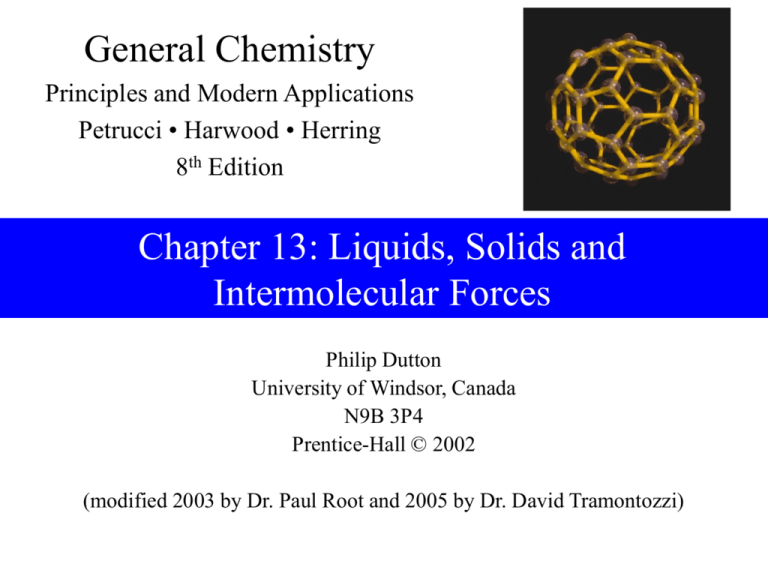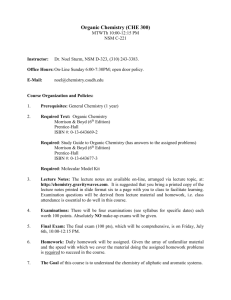Chapter 1: Matter and Measurement
advertisement

General Chemistry Principles and Modern Applications Petrucci • Harwood • Herring 8th Edition Chapter 13: Liquids, Solids and Intermolecular Forces Philip Dutton University of Windsor, Canada N9B 3P4 Prentice-Hall © 2002 (modified 2003 by Dr. Paul Root and 2005 by Dr. David Tramontozzi) Contents 13-1 13-2 13-3 13-4 13-5 13-6 13-7 13-8 13-8 Intermolecular Forces and some Properties of Liquids Vaporization of Liquids: Vapor Pressure Some Properties of Solids Phase Diagrams Van der Waals Forces Hydrogen Bonding Chemical Bonds as Intermolecular Forces Crystal structures Energy Changes in the Formation of Ionic Crystals Focus on Liquid Crystals Prentice-Hall © 2002 General Chemistry: Chapter 13 13-7 Chemical Bonds as Intermolecular Forces Two allotropes of pure carbon. Examples of network covalent solids GRAPHITE DIAMOND Prentice-Hall © 2002 General Chemistry: Chapter 13 Other Carbon Allotropes FULLERENES (C60) Prentice-Hall © 2002 General Chemistry: Chapter 13 NANOTUBES Interionic Forces The attractive force between a pair of opposite ions increases with increased charge and decreased ionic sizes. Lattice Energy is the energy given off when separated gaseous ions come together to form one mole of an ionic solid Prentice-Hall © 2002 General Chemistry: Chapter 13 13-8 Crystal Structures Regular pattern repeats itself to generate the entire crystal . The repeat unit in a crystal lattice is called the UNIT CELL. The entire lattice can be generated by simple displacements of the unit cell. Prentice-Hall © 2002 General Chemistry: Chapter 13 Unit Cells in the Cubic Crystal System Prentice-Hall © 2002 General Chemistry: Chapter 13 Holes in Crystals Tetrahedral holes fall directly over spheres. Octahedral holes fall directly over holes Prentice-Hall © 2002 General Chemistry: Chapter 13 Hexagonal Close Packed (hcp) HEXAGONAL CLOSEST PACKED All tetrahedral holes are covered. Layer C is identical to layer A CUBIC CLOSEST PACKED All octahedral holes are covered. Layer D is identical to layer A Prentice-Hall © 2002 General Chemistry: Chapter 13 Coordination Number The number of atoms with which a given atom is in direct contact Prentice-Hall © 2002 General Chemistry: Chapter 13 Counting Cell Occupancy Prentice-Hall © 2002 General Chemistry: Chapter 13 X-Ray Diffraction Need to use much shorter wavelength than visible light to interact with atoms Prentice-Hall © 2002 General Chemistry: Chapter 13 X-Ray Diffraction Using the Bragg equation nλ = 2dsinθ we can calculate the spacing between planes of atoms, ions or molecules and therefore determine the crystal structure. Prentice-Hall © 2002 General Chemistry: Chapter 13 Holes in Crystals Summary of ionic ratios 0.225 < r+ /R- < 0.414 Tetrahedral hole of fcc anions occupied by cation 0.414 < r+ /R- < 0.732 Octahedral hole of fcc anions occupied by cation 0.732 < r+ /RCubic hole of cubic anions occupied by cation Prentice-Hall © 2002 General Chemistry: Chapter 13 Cesium Chloride Ratio of cation to anion is 0.934 (169/181). Cesium occupies cubic hole made by anions Prentice-Hall © 2002 General Chemistry: Chapter 13 Sodium Chloride Ratio of cation to anion is 0.55 (99/181). Sodium occupies octahedral hole made by anions Prentice-Hall © 2002 General Chemistry: Chapter 13 Atomic Radii from Crystal Structures Prentice-Hall © 2002 General Chemistry: Chapter 13 Other unit cells of greater complexity Prentice-Hall © 2002 General Chemistry: Chapter 13 13-9 Energy Changes in the Formation of Ionic Crystals Prentice-Hall © 2002 General Chemistry: Chapter 13 Chapter 13 Questions 1, 3, 4, 13, 24, 26, 31, 45, 52, 61, 94, 107 Prentice-Hall © 2002 General Chemistry: Chapter 13 Upcoming Office Hours • Where: Science Resource Centre • When: Hours will be posted on the SRC door – – – – – – – Friday Monday Wednesday Friday Monday Wednesday Friday Prentice-Hall © 2002 December 2nd December 5th December 7th December 9th December 12th December 14th December 16th General Chemistry: Chapter 13 9am-1pm 9am-1pm 9am-1pm 11am-1pm 9am-1pm 9am-1pm 9am-4pm







